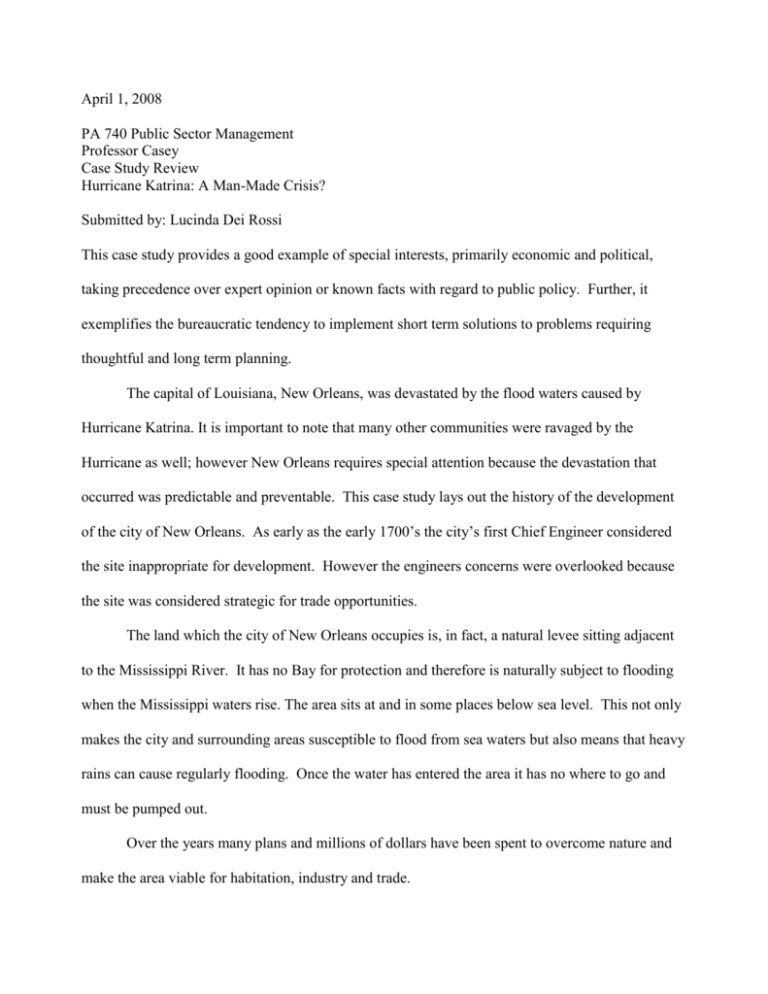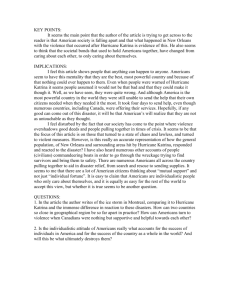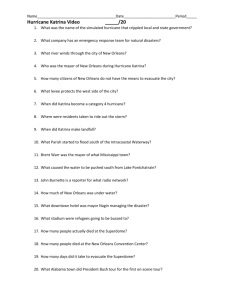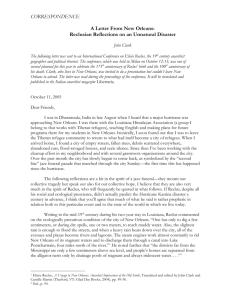case study Katrina
advertisement

April 1, 2008 PA 740 Public Sector Management Professor Casey Case Study Review Hurricane Katrina: A Man-Made Crisis? Submitted by: Lucinda Dei Rossi This case study provides a good example of special interests, primarily economic and political, taking precedence over expert opinion or known facts with regard to public policy. Further, it exemplifies the bureaucratic tendency to implement short term solutions to problems requiring thoughtful and long term planning. The capital of Louisiana, New Orleans, was devastated by the flood waters caused by Hurricane Katrina. It is important to note that many other communities were ravaged by the Hurricane as well; however New Orleans requires special attention because the devastation that occurred was predictable and preventable. This case study lays out the history of the development of the city of New Orleans. As early as the early 1700’s the city’s first Chief Engineer considered the site inappropriate for development. However the engineers concerns were overlooked because the site was considered strategic for trade opportunities. The land which the city of New Orleans occupies is, in fact, a natural levee sitting adjacent to the Mississippi River. It has no Bay for protection and therefore is naturally subject to flooding when the Mississippi waters rise. The area sits at and in some places below sea level. This not only makes the city and surrounding areas susceptible to flood from sea waters but also means that heavy rains can cause regularly flooding. Once the water has entered the area it has no where to go and must be pumped out. Over the years many plans and millions of dollars have been spent to overcome nature and make the area viable for habitation, industry and trade. The city continued to grow and prosper as economic incentives were provided to corporations. At the same time the development of highways and the reclamation of greater amounts of land shifted the population. Those that could afford to move to outlying areas did so and those who could not were left behind in the danger zones. It is important to note here that in the early 1700’s people subjected to slavery from Africa were brought into the area as a means to increase production of goods for trade. Additionally, their labor went into the construction of 10 miles of ditches and levees to control the flood waters. The historical disparity of earnings among black and white citizens has led to the neighborhoods most at risk being populated primarily by poor black Americans. Because of this population configuration, black Americans were disproportionately affected by Hurricane Katrina. It does certainly lead one to wonder if there would have been a different response to the citizen’s hardest hit if they were primarily white and/or wealthy. The bulk of industry in the flood zone appears to be petrol/chemical plants. As there were no reports of oil spills or other toxins being released during the Hurricane, it leads me to believe that these companies had prepared for the type of hurricane that blew in. While corporate interests appeared to have protected themselves. The government did not prepare for the inevitability that the City and its inhabitants would be devastated by a level four hurricane. Following the disaster Congress and others set out to evaluate why so many lives and homes were lost. There area a multiplicity of contributing factors. An emergency disaster plan was developed at the local level, but was inadequately funded and not completed at the time of the hurricane. Additionally, control over emergency disaster relief was delegated to the local level. The Mayor and the Governor were primarily responsible for ensuring the safety of the population. Unfortunately, they did not issue an evacuation order until 19 hours before the hurricane hit. Further, apparently the Mayor and Governor had not planned for how those individuals with no automobiles or other resources to leave the area would be provided for. While plans were made to use various facilities for shelter, these were completely inadequately staffed and had no capacity for food, water, security or sanitation for the thousands of people displaced. While inadequate resources were provided by the local governments, the federal government played its own role in the disaster. Under George Bush, the federal agency responsible for domestic disaster relief was reorganized under Homeland Security and the individual responsible for FEMA had no disaster relief experience. Because the federal government considered the local government the lead agencies, they relied on the bureaucratic lines of communication, appropriate signatures and line of authority before they acted. Therefore, it appears that no-one was in charge. There was no local capacity and the FEMA chose not to take over when it became obvious that the local or State government could not manage the situation. FEMA blamed the Mayor and Governor for not requesting assistance and not providing the appropriate signatures. Was this a man-made disaster? Certainly history reveals that the dangers were well known. Further, resources were thrown at resolving this problem for decades with no adequate solution. It appears that short term economic gain was the driving force of protecting the area, not the safety of citizens. If safety were the main issue, logic would tell us that the billions of resources used to protect the land from flooding would have been better spent re-locating citizens to higher ground. For many historical reasons, those with resources and those with corporate interests protected themselves and those unable to protect themselves were left to rely on the frailty of an impersonal bureaucratic system.











